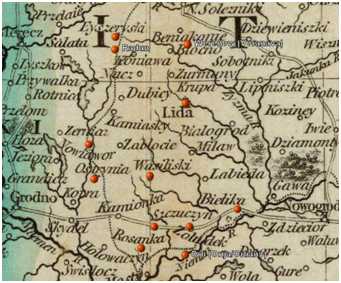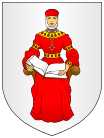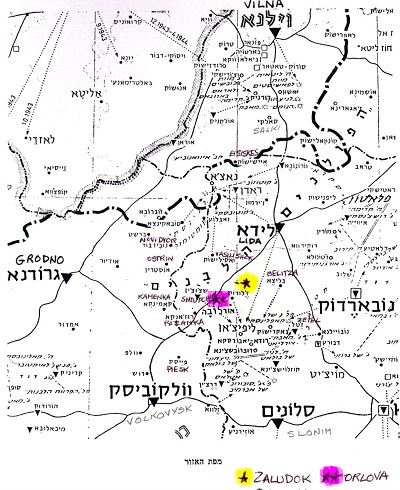|
Alternate
names: Iwye and Іvўе [Bel], Ivye and Ивье [Rus], Iwje
[Pol], Ivia and איוויע
/ אייוויע [Yid],
Vija [Lith], Ivje [Latv], Iwia,
Iwie, Ivie, Iv'ye, Iŭe, Iŭje. 53°56' N, 25°46' E, 19
miles E of Lida, 23 miles N of Navahrudak (Nowogródek).
and the dependent villages of Chowanszczyzna,
Stolniewicze/Stolniewicz, Urciszki
and hamlets, estates, colonies of Dyndyliszki and Zalejki
Iwje should not be confused with Jewe, in Tro province, on the road
from Vilna to Kaunas.
Ivje is a small town in Ivje region on the river Ivjyanka. Population: 8,600 people in 1995.
Jewish population: 573 (in 1897), 2,076 (in 1921). Ivye was mentioned
first in the Chronicles as a fifteenth century Grand Duchal residence.
The Grand Duke of the Grand Duchy of Lithuania, Kazimir, gave it to the
Governor of Novogrudok, Petr Mantygerdovich, who established a Catholic
church in 1495. In the first half of the sixteenth century, it belonged
to Duke Zaberezinski. In 1551, Ivye was a mestechko in Oshmyany povet.
From 1558 to 1654, Ivye belonged to Kishki. In the second half of the
sixteenth century, Ivye was one of the centers of Oriyanstvo district
in the Grand Duchy of Lithuania with a school and a book-printing
house. The director of the school in 1585-1593 was Y. L. Namyslovski.
In 1598, Of the two taverns and 129 houses, nineteen were given to
Tatars in the territory outside of Ivje. Jews first settled in Ivye in
the early 1600s and mentioned in the records of the Lithuanian Council
(Councils of the Lands) tax records. A
Moses from I. is named as
taxpayer in the Pinkas of the Lithuanian Council in 1623. The community paid a poll tax for
its members directly to the Council, and was thus independent of all
five of the leading Communities of Lithuania.
The Jewish community was involved primarily in
innkeeping, brandy distillation, estate leases, and dairies. In 1630,
Kishka gave Petropavlovskya Catholic Church to the Bernandinski Order.
At the same time, a wooden Catholic church was built there. There was a
school, a hospital, and a library belonging to the Catholic church. In
1634, the mestechko consisted of a market place and three streets with
180 houses.From mid-seventeenth century to the first half of the
nineteenth century, owners of Ivye were Sluzhka, Glebovich, Zhizhemski,
Oginski, Sapega, and Tezengauz. In
1761 the Jews paid [along with the Association of Jews in Lipniski] 600
gulden to the Council in Sltutzk. In
1795, Russian Empire control began. Beginning in 1843, Ivye belonged to
Duke Zamoiski. The 1847 Jewish population was 804. In 1891, when a fire
damaged over one hundred Jewish homes, many Jews moved elsewhere. In
1897, it was a volostj center in Oshmyany povet of Vilno gubernya with
2,828 people, 387 houses, a Catholic church, two synagogue, three
Jewish prayer houses, a technical school, a pharmacy, one mill,
seventeen shops, four taverns, and five annual fairs. The 1897 Jewish
population was 573 (15.7% of the population).In
1915, the Red Army and the Polish Army occupied Ivye. In 1921-1939, it
belonged to Poland as a mestechko center of the gmina in Volozhin povet
in Novogrudok voevodstvo. In 1921, under Polish rule, the Jewish
population increased to 2,100 or about 76% of the population. At that
time, the town also had a Tarbut school and a Jewish female elementary
school. In 1928, Iwye was a mezteczko (small city) and gmina wiejska
(parish town) and seat of the community council for the surrounding
villages, in the first uchastok, Lida powiat, Nowogrodskie woj.,
Poland. The Justice of the Peace was in Ivye and the Justice Court in
Wilno. The 1928 miasteczko population was 2,731. The railway station
was five kilometers away (a train stop for limited transports) on the
Gawja-Iwje line. The post office, telegraph and telephone were in Iwje
k. Lidy. Iwje had one Catholic church, a Merchants Association, an
Artisans Association, mills, and tanneries. Markets were on Wednesdays.The
USSR, who ruled the town from 1939 to 1941, dissolved Jewish community
institutions and outlawed Zionist activity. The Tarbut School became a
Yiddish state school. Conscription into the Red Army was enforced on
June 22, 1941. Beginning in 1939, Ivye belonged to BSSR. On January 15,
1940, Ivye became a small town and regional center. The Beginning June
29, 1941 until July 8 1944, the Nazis occupied the town and killed more
than the 2,621 people in Ivje and the environs reported by the
Belarussians. On the ninth of Av, about 225 Jewish intellectuals were
murdered. A ghetto was enforced in September of 1941. On May 12, an
aktion murdered about 2,500 of the Jewish residents. Contact with
partisans in the adjacent forests began. One group joined Tuviah
Bielski. The murders continued in the town until January 20, 1943 when
the remaining 1,100 Jews were moved to Borisov where they perished. In
1971, there were 5,000 people, a bakery, a cannery, forestry
operations, a secondary school, a music school, a sports school, a
youth center, four kindergartens, a house of culture , two libraries,
and a hospital. There are monuments to the victims of fascism (Nazis).
Architectural monuments: Petropavlovskaya Catholic Church (the end of
15-17 century), a mosque (1884) which still exists, and an Orthodox
church. Source: Sachenka, B.I. [editor], Encyclopedia
of the History of Belarus. Minsk: 1996. Volume 3, p. 510.
Residents
of import: Chaim Ozer Grodzinski, Rav of Vilnius, born in
Iwye, and Moshe Shatzkes, Rav of Iwye, 1913–1941
Iwye, a drewniane miasteczko in former Vilna
province, administrative district Oszmiana, 7mil from Oszmiana and from
Lida was the former property of the Kiszka family. Mikolaj Kiszka, from
Ciechanowiec, Great Lithuania, was "castellan" in Troki and podskarbi .
Before 1538, Bernardine monks settled here and "provided by" or
"providing to" the church indispensable funds. About 1611, a Calvinist
community was founded here. At present [1863], Iwye is country town and
the property of the Tyzenhauz family. [translation
thanks to Paul Pilawa]
From Geographical
Dictionary of Polish Kingdom, Volume III, Warsaw 1882, page
325:
Iwye was a country town in the administrative
district Oszmiana. Geographical location: "53 56 widths north and 43 26
east lengths", situated 59 versts south of Oszmiana and 134 versts from
Vilna, at 514 of feet above sea level. Iwye is a country-commune
management center with a country-school, the brick Catholic parish
church of Sts. Piotr and Pawel, and a post office that communicates
with the Lida post in via the post office in Dzilkowicze, about 29.5
versts distant. Country town had 2,123 inhabitants (1,053 men and 1,070
women) in 1869. The country-commune was divided into 5 districts with
42 villages, 978 houses, and 6,243 peasants. The Catholic Parish (1st
class -?) belongs to the dekanat in
Wiszniewo that possesses Duda and the chapels in Satoltowicze with
7,646 faithful. Iwye was once the property of the Kiszka family.
Mikolaj from Czechanowiec, voivode of Mscilaw province and leader in
Wilkoszewo, founded a church here in 1631. The church was built as a
cloister; and he brought Bernadine monks to it. His maintenance of the
cloister cost 2,000 rallies a year (part of income from the estates).
This gift occurred on 10 of June 1633. The Bernardine monks had a
library containing 489 books of theological content, a cloister nursery
school, and a monastic school called "rhetoric". The school began in
the nineteenth century. The
Sluzka family bought the country town Iwye from the Kiszka family. They
received this from Katarzyna Januszowa of the House of Kiszka, the wife
of the Lithuanian hetman. In a testament, Katarzyna was recorded in
Iwye in 1662 as Karol and Katarzyna from Radziwill Hlebowicz. Karol and
Katarzyna Hlebowicz had two daughters: 1. Marcybele(?), wife of Marcyan
Oginski, of Troki voivode and Lithuanian chancellor and 2. Krystyna,
wife of Sapieha, of voivode Polock. When Marcybele Oginski died without
progeny, the Sapieha family received the country town of Iwye. In 1686,
the Sapieha family returned Iwye as a deposit to the Tyzenhauz family.
Today [1882], Iwye belongs to countesses Elfryda Zamojski, who received
it in the fall of the Tyzenhauz family. Translation thanks to Jan Sekta. another translation can be found on
the PGSA website
From BALINSKI, LIPINSKI: ANCIENT POLISH Volume IV, page 187, Warsaw 1887:
"Ivye - wooden country town about miles 7 from Oszmiana and from Lida,
formerly belonging to the Kiszkow family. Mikolaj Kiszk from
Ciechanowiec, castellan [?] from Troki and podskarbi
of Great Lithuanian before 1538 founded a
Bernardine monastery here . In 1631, he funded the church. About 1611,
someone from the Kiszka family founded the Iwye Calvinist Protestant
community. This country town finally became the property of the
Tyzenhauz family." Translation
thanks to Jan Sekta
LOCATION AFTER 1939: Baranavichy
Oblast (Belarusian: Баранавіцкая вобласць, Russian:
Барановичская Область) was a territorial unit in the Belarusian Soviet
Socialist Republic created after the annexation of West Belarus into
the BSSR in November 1939. The administrative centre of the province
was the city of Baranavichy. The voblast was originally known as the Navahrudak
Voblast but it was soon renamed to Baranavichy Voblast. The
oblast was made up of 26 raions in 1944. These raions were
Byten, Gorodyshche, Ivyanets, Iwye, Yuratishki, Karelichy, Kletsk,
Kozlovshchina, Lyakhavichy, Lida, Lubcha, Mir, Masty, Navahrudak, Nova
Mysh, Nesvizh, Radun, Slonim, Stowbtsy, Shchuchyn, Vasilishki,
Valozhyn, Voranava, Dzyatlava, Zel’va and Zheludok.
In 1944, the oblast was diminished after transferring raions
of Lida, Radun, Schuchyn, Vasilishki, Voranava, Masty, Zel’va
and Zheludok to newly founded Hrodna Voblast (Founded after
remaining parts of Belastok Region to Belarus in 1945) and ones
of Iwye, Yuratishki and Valozhyn to Molodechno Voblast in
1944. Finally on January 8, 1954 the oblast was liquidated and the
raions were divided between the Brest (Raions of Gorodyshche,
Lyakhavichy and Novo Mysh), Grodno (Byten, Karelichi, Kozlovshchina,
Lubcha, Mir, Navahrudak and Slonim), Molodechno (liquidated in 1960)
(Raion of Ivyanets) and Minsk (Raions of Kletsk, Nesvizh and Stowbtsy)
Olbasts (Modern Brest Voblast, Hrodna Voblast and Minsk Voblast). Thus,
Baranavichy became part of Brest one as raion center after Nova Mysh
one's center was moved to Baranavichy in 1 May 1954 and renaming it as
Baranavichy one after 8 April 1957.
Sources:
- Cemetery
- Holocaust Memorial for Jews from Ivye
-
Ksiega Adresowa
Handlowa, Warszawa Bydgoszcz 1929 Iwje
starts on
page 1027; page 1030 of the pdf. There is no pull down. Manually enter
the page number & then click on the text to the left of the page
input box. Dictionary of occupations
- Słownik Geograficzny Królestwa Polskiego(1880-1902),
III, p. 324: copy and paste this URL:
http://www.polishroots.org/GeographyMaps/SłownikGeograficzny/323 .For
some reason, the Polish characterł does not carry through the html linking process, but it will copy & paste.
- Wikipedia
- From: Orgelbrand-Encyklopedia General, Volume
XII , page 742, Warsaw, 1863: First some definitions of terms used:
- Podskarbi - royal clerk responsible for a
medieval king's treasury; after 16th century, a title equivalent to
"the honorable"
- Dekanat - district of ten parishes in the
Catholic Church organizational structure
- Drewniane
miasteczko - little wooden country town, not large city, in which
houses were built of wood
- Voivod
- local ruler or governor
- Encyclopedia Judaica; Dubnow,
S. Pinchas ha-Medinah (1925); Kaganowitz, M. (editor) Ivye's entry is on p 822 of this volume, pdf page 824
- Yad Vashem:
7310, Hebrew, 1 Mar 1973, KAPLAN, Yosef: Jews of Lida under Soviet
rule; members of the Judenrat (with names); German workers Werner,
Windisch an Hannweg; residents of the neighborhood, WASILISKI, IWJE,
WORONOW in the Lida ghetto; failed escapes; escape of the couple Kaplan
and their joining the Soviet partisan group Iskra; sabotage and
battles.
- Yad Vashem: p.
18 224540 Yiddish, 11 Aug 1947, Statistical data on the extermination
of Jews in 1942 in various communities: LIDA, IVJE, WASILIZHKI,
DOLHINOW and others
- Shtetl Finder
(1989), p. 31: "Ivia".
- Yizkors:
- Pinkas HaKehilot,
Poland, Vol. 8 (2005), pp. 117-120: "Iwje".
- Encyclopedia of Jewish Life (2001), pp.
553-554: "Iwje".
- Еврейская
энциклопедия (1906-1913), "Ивье".
- Sefer
Zikkaron li-Kehillat Ivye (H/Y), Tel Aviv, 1968
- JGFF
Town Search.
- Simon
Wiesenthal Center Holocaust link.
Try http://motlc.wiesenthal.com/site/pp.asp?c=gvKVLcMVIuG&b=394845
in the Internet Archive & see if you have better luck than I did in
Aug 2020
- JGSNY
Home Page, See "NY Landsmanshaftn and other organizations.
Scroll to "Incorporation Papers".
- US
Holocaust Memorial Museum
- HaMelitz Lithuanian Charity Donors Database
- Pinkas
HaKehilot, Poland, Vol. 8 (2005)
- Lithuanian Jewish Communities
(1991)
- Encyclopedia
of Jewish Life (2001)
- Еврейская
энциклопедия (1906-1913)
- JGFF
JewishGen Family Finder
- Rogoff, Tamar "Summer in Ivye" 2001. video
- Shumkler, Arie Hulyah
ba-sharsheret Ramat-Gan:
A. Shmukler, 1982. privately published autobiography of a Holocaust
survivor from Iwje.
- Yizkor
Book: Iwje and Lipnishki, with Gavia and Traby
- Incorporation papers for 2 Landmanshaftn for
people from Ivje. Jewish Genealogical Society of
New York Home Page, See: "New York Landsmanshaften & Other
Organizations" for Evia and Ivye.
- Beth Haknesseth Anshe Alshan V'Anshe
Iwie is
listed in a 1939 WPA inventory of existing and recently closed Shuls. Founded
by groups from Alshan [Alsinai] and Iwje in 1888, they had a 2-story
brick building on 63 Montgomery St. in NYC from 1906, and rented a loft
at 32 Chrystie St. before that. These data are from card #52, on reel
321 of the WPA microfilm series at the New York Municipal Archives on
31 Chambers St.
On reel 322, #184 is the additional
information that the Secretary is B. Schmokkler, 213 E. Broadway,
& that there's a death register going back 50 years &
one membership ledger going back 30 year. We have no information as to
the fate of these records in the intervening 1/2 century!
In a 1921 Directory, the Rabbi was listed as H. Lipnitsky.
Pictures:
- postcard of Iwje from World War I
- Pictures of Iwje from May 1999
trip by Harriet Kasow
- YIVO's on-line photgraph
collection has
14 pictures of Ivye
- Photograph made in an Iwje photographic
studio
- pictures of Ivye at the bottom
of the Ivye frame in Shtetls
of Belarus
- Holocaust
Monument in Ivye, taken in July 2003. donated by
Kazimierz Niechwiadowicz
- The
school
in Iwje, 1938. donated by Kazimierz Niechwiadowicz
- small cemetery in Lipniszki, taken in Aug
2002. donated by Kazimierz Niechwiadowicz
- Kazimierz Niechwiadowicz gave
me 4 images of former residents of
Subotniki, taken in
the 1930s: 1.Fire
Brigade, 2.
school children on a trip to Vilnius, 3. 4
men, of whom one is Tuvia Bielski and two
others are policemen, and 4. 1937
wedding of Jan Szpinta
& Ola Soltan, which includes Mones Daniel. If anyone recognizes
a person still living in them, please
contact me.
- Two further group
shots of
school children, of whom some are very likely Jewish. If anyone
recognizes a person still living in them, please contact me
If
you have Lida uezd
materials to share, please considering donating it.
If you read Yiddish or Hebrew, please contact us.
Records are
held both in Grodno and Vilna archives.For Lida records translation,
your tax deductible contribution by credit card via the secure server
at either group or by mail will grow our knowledge. For a $100
donation, you receive all these records translated two years ahead of
their posting on JewishGen. Every penny collected is used for Lida uezd
projects only. Records include censuses; family lists; marriages,
births, death records; prenumeraten lists; and more. Please contact Judy Baston
with any questions.For current translations, please see the ALD:
All Lithuanian Database and Belarus
SIG Database.
|
|



